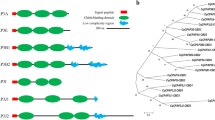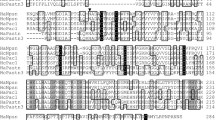Abstract
Synthesis of chitin is a subject of great interest in the fields of physiology and immunology of crustaceans. Chitinous tissues include not only the carapace, but also an acellular membrane in the intestine called the peritrophic membrane (PM). Here, we describe the first report of chitin synthase (CHS) of a penaeid shrimp, kuruma shrimp Penaeus japonicus. Histological observations showed that fecal matter in the midgut of kuruma shrimp was wrapped with a PM, which physically separated it from the midgut epithelium. Subsequently, the chitin synthase transcript was amplified from the midgut of the shrimp. The chitin synthase gene of kuruma shrimp (MjCHS) encodes 1,523 amino acid residues. Structural prediction analysis showed that the N-terminal region of MjCHS protein included nine transmembrane helices, the middle region included the catalytic region with several conserved motifs which are found in CHSs from other arthropods, and the C-terminal region included seven transmembrane helices. Although insects have distinct exoskeletal and intestinal chitin synthases, the phylogenetic analysis suggested that crustaceans have a single CHS. MjCHS mRNA was constantly detected in the digestive tract, including the midgut and hepatopancreas of both juvenile and adult kuruma shrimp, suggesting a stable synthesis of chitin in those organs. In contrast, MjCHS mRNA was also detected in the hindgut and uropod of juvenile shrimp. After molting, the mRNA levels of MjCHS in the stomach and uropod were higher than other molting cycles. These results suggest that MjCHS contributes to chitin synthesis in both the digestive tract and the epidermis, providing fundamental insights into chitin synthesis of crustaceans.





Similar content being viewed by others
Data Availability
The nucleotide sequence for the P. japonicus CHS is available on DDBJ database (MjCHS, LC769888).
References
Abehsera S, Glazer L, Tynyakov J, Plaschkes I, Chalifa-Caspi V, Khalaila I et al (2015) Binary gene expression patterning of the molt cycle: the case of chitin metabolism. PloS One 10:e0122602
Arakane Y, Muthukrishnan S, Kramer KJ, Specht CA, Tomoyasu Y, Lorenzen MD et al (2005) The Tribolium chitin synthase genes TcCHS1 and TcCHS2 are specialized for synthesis of epidermal cuticle and midgut peritrophic matrix. Insect Mol Biol 14:453–463
Bell TA, Lightner DVA (1998) Handbook of Normal Penaeid Shrimp Histology. World Aquaculture Society, Baton Rouge, LA, USA
Ceccaldi HJ (1998) Anatomy and physiology of digestive tract of Crustaceans Decapods reared in aquaculture. Adv Tropical Aquaculture, Workshop at Tahiti, French Polynesia 9:243–259
Chen WY, Ng TH, Wu JH, Chen JW, Wang HC (2017) Microbiome dynamics in a shrimp grow-out pond with possible outbreak of acute hepatopancreatic necrosis disease. Sci Rep 7:9395
de la Pena LD, Nakai T, Muroga K (1995) Dynamics of Vibrio sp. in organs of orally infected Kuruma prawn, Penaeus japonicus Fish Pathol 30:9–45
de Oliveira Cesar JR, Zhao B, Malecha S, Ako H, Yang J (2006) Morphological and biochemical changes in the muscle of the marine shrimp Litopenaeus vannamei during the molt cycle. Aquaculture 261:688–694
Doucet D, Retnakaran A (2012) Insect chitin: metabolism, genomics and pest management. Adv Insect Physiol 43:437–511
Erlandson MA, Toprak U, Hegedus DD (2019) Role of the peritrophic matrix in insect-pathogen interactions. J Insect Physiol 117:103894
Holt CC, Bass D, Stentiford GD, van der Giezen M (2021) Understanding the role of the shrimp gut microbiome in health and disease. J Invertebr Pathol 186:107387
Imaizumi K, Tinwongger S, Kondo H, Hirono I (2021) Analysis of microbiota in the stomach and midgut of two penaeid shrimps during probiotic feeding. Sci Rep 11:9936
Imaizumi K, Molex W, Jitnavee C, Direkbusarakom S, Kondo H, Hirono I (2022) Bacterial and eukaryotic communities in pond water of whiteleg shrimp Litopenaeus vannamei and the bacterial communities of their stomach and midgut. Aquaculture 554:738139
Kawato S, Nishitsuji K, Arimoto A, Hisata K, Kawamitsu M, Nozaki R et al (2021) Genome and transcriptome assemblies of the kuruma shrimp, Marsupenaeus japonicus. G3 Genes Genom Genet 11:jkab268
Kelkenberg M, Odman-Naresh J, Muthukrishnan S, Merzendorfer H (2015) Chitin is a necessary component to maintain the barrier function of the peritrophic matrix in the insect midgut. Insect Biochem Mol Biol 56:21–28
Kumar MNR (2000) A review of chitin and chitosan applications. React Funct Polym 46:1–27
Kumar S, Stecher G, Li M, Knyaz C, Tamura K (2018) MEGA X: molecular evolutionary genetics analysis across computing platforms. Mol Biol Evol 35:1547
Kuraishi T, Binggeli O, Opota O, Buchon N, Lemaitre B (2011) Genetic evidence for a protective role of the peritrophic matrix against intestinal bacterial infection in Drosophila melanogaster. Proc Natl Acad Sci 108:15966–15971
Lai HC, Ng TH, Ando M, Lee CT, Chen IT, Chuang JC et al (2015) Pathogenesis of acute hepatopancreatic necrosis disease (AHPND) in shrimp. Fish Shellfish Immunol 47:1006–1014
Lemos D, Weissman D (2021) Moulting in the grow-out of farmed shrimp: a review. Rev Aquac 13:5–17
Lightner DV, Hasson KW, White BL, Redman RM (1996) Chronic toxicity and histopathological studies with Benlate®, a commercial grade of benomyl, in Penaeus vannamei (Crustacea: Decapoda). Aquat Toxicol 34:105–118
Martin GG, Natha Z, Henderson N, Bang S, Hendry H, Loera Y (2020) Absence of a microbiome in the midgut trunk of six representative Crustacea. J Crust Biol 40:122–130
Martin GG, Simcox R, Nguyen A, Chilingaryan A (2006) Peritrophic membrane of the penaeid shrimp Sicyonia ingentis: structure, formation, and permeability. Biol Bull 211:275–285
Merzendorfer H, Zimoch L (2003) Chitin metabolism in insects: structure, function and regulation of chitin synthases and chitinases. J Exp Biol 206:4393–4412
Mohammed AM, Diab MR, Abdelsattar M, Sayed MS (2017) Characterization and RNAi-mediated knockdown of Chitin Synthase A in the potato tuber moth. Phthorimaea Operculella Sci Rep 7:9502
Moussian B, Schwarz H, Bartoszewski S, Nüsslein-Volhard C (2005) Involvement of chitin in exoskeleton morphogenesis in Drosophila melanogaster. J Morphol 264:117–130
Nakashima K, Kimura S, Ogawa Y, Watanabe S, Soma S, Kaneko T et al (2018) Chitin-based barrier immunity and its loss predated mucus-colonization by indigenous gut microbiota. Nat Commun 9:3402
Niu GJ, Yan M, Li C, Lu PY, Yu Z, Wang JX (2022) Infection with white spot syndrome virus affects the microbiota in the stomachs and intestines of kuruma shrimp. Sci Total Environ 839:156233
Restrepo L, Domínguez-Borbor C, Bajaña L, Betancourt I, Rodríguez J, Bayot B et al (2021) Microbial community characterization of shrimp survivors to AHPND challenge test treated with an effective shrimp probiotic (Vibrio diabolicus). Microbiome 9:88
Rinaudo M (2006) Chitin and chitosan: Properties and applications. Prog Polym Sci 31:603–632
Rocha J, Garcia-Carreño FL, Muhlia-Almazán A, Peregrino-Uriarte AB, Yépiz-Plascencia G, Córdova-Murueta JH (2012) Cuticular chitin synthase and chitinase mRNA of whiteleg shrimp Litopenaeus vannamei during the molting cycle. Aquaculture 330:111–115
Soonthornchai W, Chaiyapechara S, Jarayabhand P, Söderhäll K, Jiravanichpaisal P (2015) Interaction of Vibrio spp. with the inner surface of the digestive tract of Penaeus monodon. PloS One 10:e0135783
Tellam RL, Wijffels G, Willadsen P (1999) Peritrophic matrix proteins. Insect Mol Biol 29:87–101
Thuong KV, Tuan VV, Li W, Sorgeloos P, Bossier P, Nauwynck H (2016) Per os infectivity of white spot syndrome virus (WSSV) in white-legged shrimp (Litopenaeus vannamei) and role of peritrophic membrane. Vet Res 47:39
Tran L, Nunan L, Redman RM, Mohney LL, Pantoja CR, Fitzsimmons K et al (2013) Determination of the infectious nature of the agent of acute hepatopancreatic necrosis syndrome affecting penaeid shrimp. Dis Aquat Org 105:45–55
Wang L, Li F, Wang B, Xiang J (2012a) Structure and partial protein profiles of the peritrophic membrane (PM) from the gut of the shrimp Litopenaeus vannamei. Fish Shellfish Immunol 33:1285–1291
Wang Y, Fan HW, Huang HJ, Xue J, Wu WJ, Bao YY, Xu HJ, Zhu ZR, Cheng JA, Zhang CX (2012b) Chitin synthase 1 gene and its two alternative splicing variants from two sap-sucking insects, Nilaparvata lugens and Laodelphax striatellus (Hemiptera: Delphacidae). Insect Biochem Mol Biol 42:637–646
Ye C, Jiang YD, An X, Yang L, Shang F, Niu J (2019) Effects of RNAi-based silencing of chitin synthase gene on moulting and fecundity in pea aphids (Acyrthosiphon pisum). Sci Rep 9:3694
Zhang J, Liu X, Zhang J, Li D, Sun Y, Guo Y, Ma E, Zhu KY (2010) Silencing of two alternative splicing-derived mRNA variants of chitin synthase 1 gene by RNAi is lethal to the oriental migratory locust, Locusta migratoria manilensis (Meyen). Insect Biochem Mol Biol 40:824–833
Zhang X, Yuan J, Sun Y, Li S, Gao Y, Yu Y et al (2019) Penaeid shrimp genome provides insights into benthic adaptation and frequent molting. Nat Commun 10:356
Funding
This work was supported by Sasakawa Scientific Research Grant from the Japan Science Society (2020–4063). This work was also supported in part by the Japan Science and Technology Agency /Japan International Cooperation Agency, Science and Technology Research Partnership for Sustainable Development (SATREPS JPMJSA1806).
Author information
Authors and Affiliations
Contributions
Conceptualization: Kentaro Imaizumi, Ikuo Hirono; Methodology: Kentaro Imaizumi, Motohiko Sano, Hidehiro Kondo, Ikuo Hirono; Formal analysis: Kentaro Imaizumi; Resources: Kentaro Imaizumi, Motohiko Sano, Hidehiro Kondo, Ikuo Hirono; Writing—original draft: Kentaro Imaizumi; Writing—review & editing: Kentaro Imaizumi, Motohiko Sano, Hidehiro Kondo, Ikuo Hirono; Supervision: Hidehiro Kondo, Ikuo Hirono; Project administration: Kentaro Imaizumi, Ikuo Hirono; Funding acquisition: Kentaro Imaizumi, Motohiko Sano, Hidehiro Kondo, Ikuo Hirono.
Corresponding author
Ethics declarations
Competing Interests
The authors declare no competing or financial interests.
Additional information
Publisher's Note
Springer Nature remains neutral with regard to jurisdictional claims in published maps and institutional affiliations.
Rights and permissions
Springer Nature or its licensor (e.g. a society or other partner) holds exclusive rights to this article under a publishing agreement with the author(s) or other rightsholder(s); author self-archiving of the accepted manuscript version of this article is solely governed by the terms of such publishing agreement and applicable law.
About this article
Cite this article
Imaizumi, K., Sano, M., Kondo, H. et al. Insights Into a Chitin Synthase of Kuruma Shrimp Penaeus japonicus and Its Role in Peritrophic Membrane and Cuticle Formation. Mar Biotechnol 25, 837–845 (2023). https://doi.org/10.1007/s10126-023-10244-1
Received:
Accepted:
Published:
Issue Date:
DOI: https://doi.org/10.1007/s10126-023-10244-1




